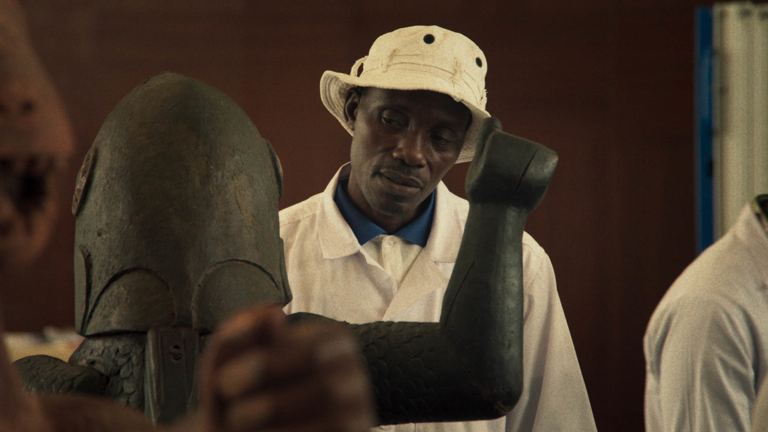Review by In the Frame critic Abigail Reeves
As part of our In the Frame program, five emerging film critics had the opportunity to watch, reflect on and review films in the Perth Festival Lotterywest Films 2024 – 25 season.
Repatriation is a word most often bandied around in academic institutions, becoming the subject of purely theoretical debates on its practicality and ethical implications. While it is ceaselessly talked over by professors and public intellectual figures, it remains an intangible dream for those victimised by colonial regimes, robbed and left destitute while the west bathes in its riches. Repatriation has been dismissed as a fiction, an idealistic daydream whose unfolding is deemed too disruptive to the established status quo. Mati Diop’s Dahomey takes a radical departure from these euro-centric ponderings and imperial pandering to demonstrate the impossible is not so difficult after all when our perspective shifts.
The journey of 26 works of art from the sterile halls of the Musée du quai Branly in Paris to the Abomey Historical Museum in Benin is chronicled as a celebratory – though not uncomplicated – return. The events Diop captures on screen took place in 2022, a process which originated in a 2018 report into the restitution of African cultural heritage that applied to 90,000 works in French museums. The 26 artefacts who function as the stars of Diop’s film were originally pillaged by the imperial French army in 1892, two years before the official colonisation of the Kingdom of Dahomey into West Africa. The breakout star is a 500-pound bronze statue of King Ghezo, ruler of the kingdom from 1818 to 1858, whose internal monologue narrates his re-awakening, expressing his own desires and fears for the journey ahead.
After spending 129 years displaced from their homeland, King Ghezo and his compatriots return to the Kingdom of Dahomey, now known under another name: the nation state of Benin. These years spent captive, left in storage underneath the Louvre and its wealth of cultural capital, have kept them hostage long enough to see the French empire rise and crumble, and return to a vastly different world to the one they were brought to life in.
This liberation takes the form of a secondary displacement, as these artefacts embark on the impossible journey of return. On a global scale, the flow of goods, minerals, people and resources is primarily uni-directional, a relationship established by extractive colonial economies that form the basis for the current neo-imperial world order. Diop takes us alongside these artworks on the road less travelled – literally. We are embedded in the box alongside King Ghezo, entombed with the bronze king and his internal monologue in the pitch black as he imagines what awaits him. The sonic experience is all-consuming, mimicking an ASMR-style immersion into the physical act of travel – a practical part of repatriation often forgotten.
What makes Diop’s filmmaking so radical is the ethics of plurality with which she approaches her subjects. Formally, the film is a hybrid being itself, evading traditional genre boundaries and blending fly-on-the-wall camera work underscored by King Ghezo’s spectral monologue to create something not wholly documentary nor fiction. This voiceover was done as a collage of both male and female voices, written by Haitian author Makenzy Orcel, functioning as a chorus speaking as one. Additionally, Diop portrays multi-faceted viewpoints on repatriation as she includes long segments of a debate between university students in Abomey. They each take a different perspective on this topic: acknowledging the importance of cultural heritage for the youth, the insult of France giving back a miniscule 26 out of 7,000 artworks stolen from Benin, discussing the relation of repatriation to economic concerns. These fears, desires, hopes and critiques are expressed in turn to create a multi-dimensional picture of what repatriation means to those for whom it holds immense potential. Diop chronicles not only the return of these 26 artworks but also the return of the voice and stage to African youth who she described as having been “dispossessed of their history”.
Documentaries drawing on Western traditions frequently include a singular narrator whose function is to provide an authoritative account of what is happening and additional information to guide our viewpoint. This definitive voice is entirely lacking from Diop’s film, whose information is inscribed within each sequence of images, or conversely in the deep, reverberating thoughts of King Ghezo as blackness fills the screen.
In a tight 68 minutes, Diop succinctly undermines established narratives around repatriation while forging a new vision for the future; one which unfolds far from the stuffy confines of European museums or paternalist intellectuals. This future places the youth at the forefront, without a singular figurehead to make decrees; a future which heralds the return of agency and voice to those long ignored.
